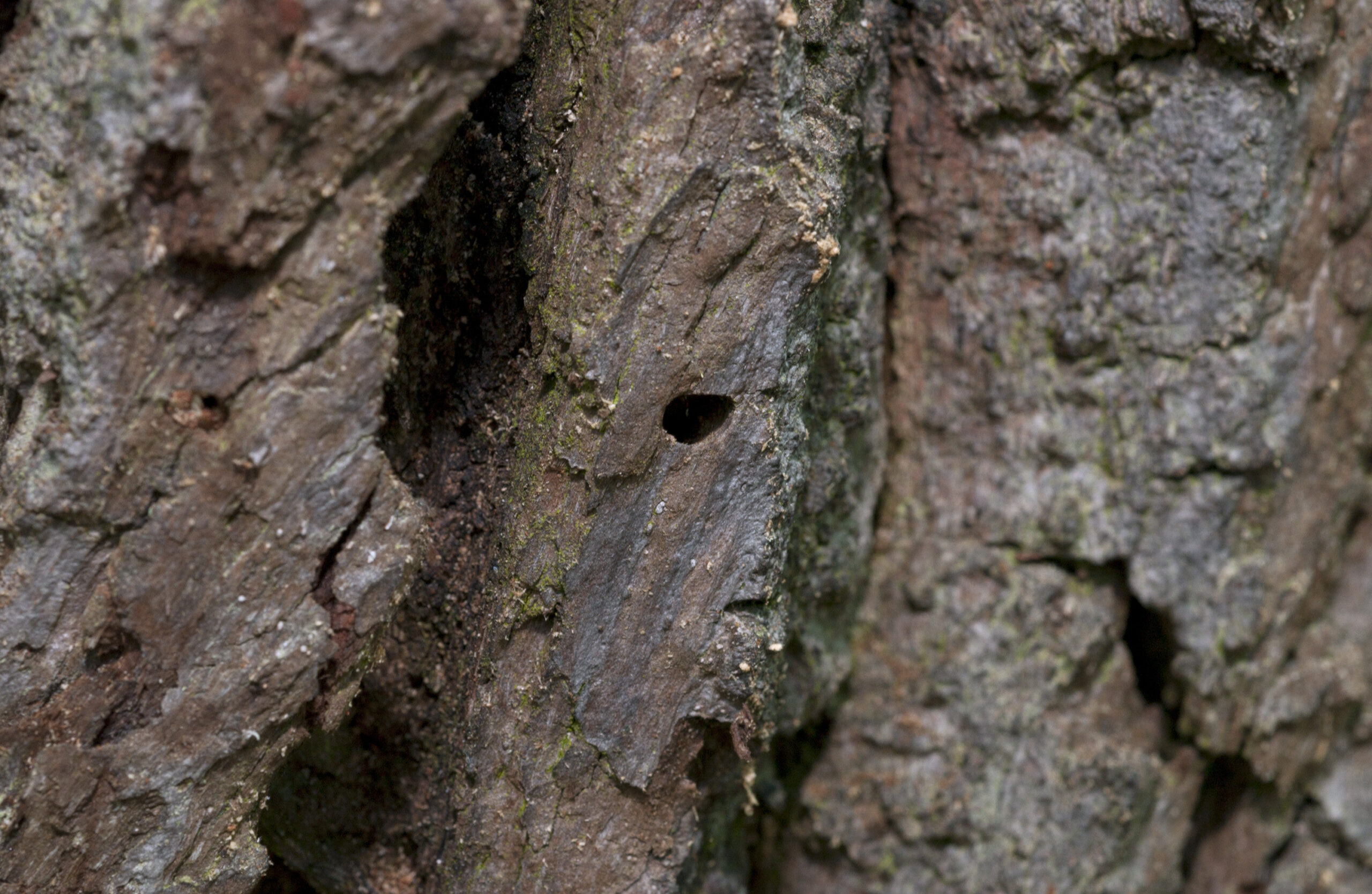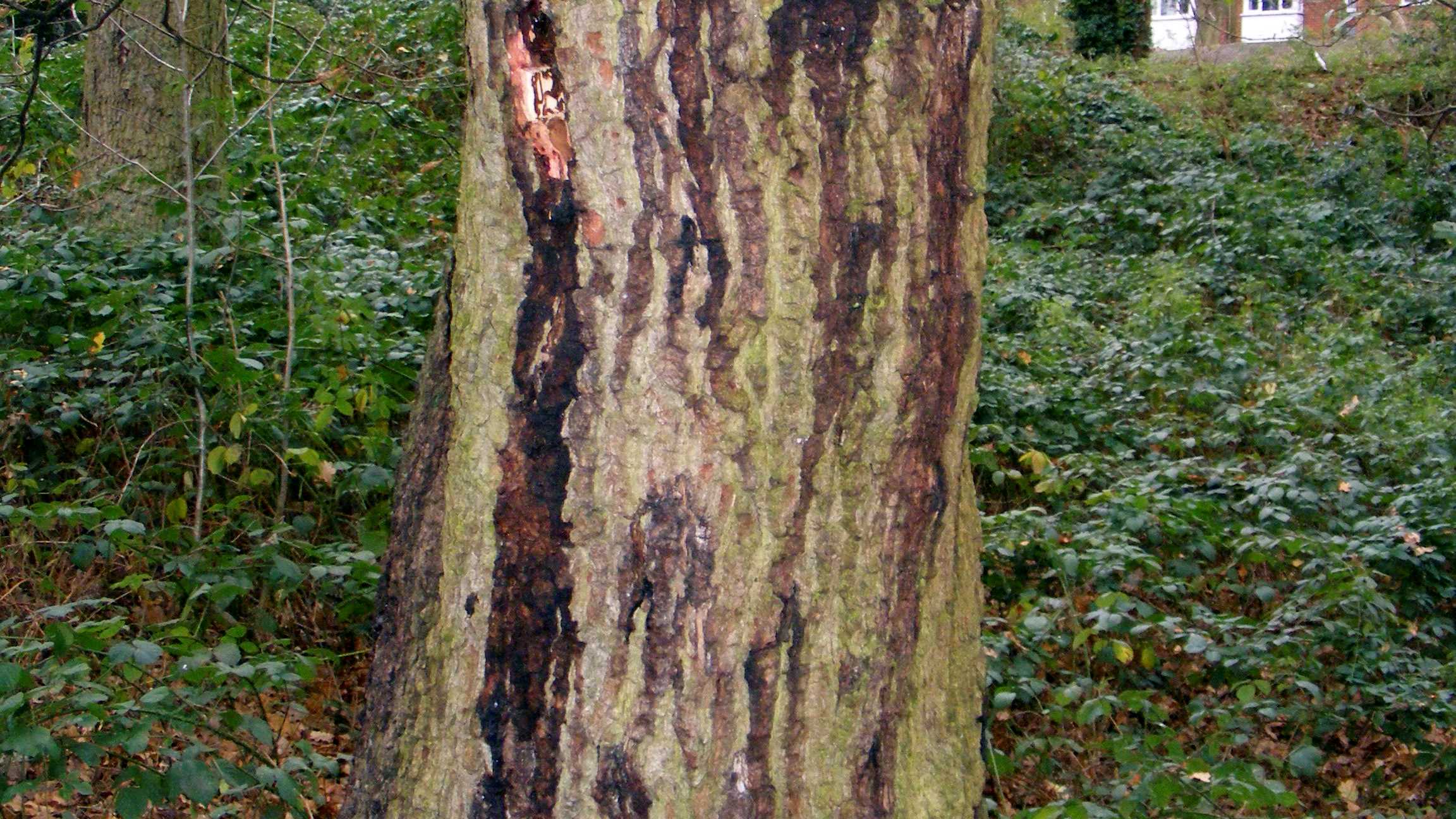Managing and Limiting Acute Oak Decline (AOD)
Oak is an iconic tree. Its timber is one of our most valuable woodland products. Hundreds of jobs and businesses depend on it to some extent. Forestry Consultant Andrew Woods is an RFS Past President and has represented the RFS on the Action Oak initiative.
Andrew first came across Acute Oak Decline (AOD) in Worcestershire in 2012 and talks about his experiences here. Thinning and good management, he says, is key.
Below. The ‘D’ shaped exit hole of the two-spotted oak buprestid beetles (Agrilus biguttatus). All pictures: Copyright Forest Research

Acute Oak Decline was first identified in the UK in the late 20th century in Eastern England. It was flagged up by timber users with a specific interest in oak and its milling potential. It was then identified elsewhere. My first involvement with it came in Worcestershire in 2012 or thereabouts.
AOD is caused by a combination of factors. These include environmental stress and, often, weakening from the impact of the two-spotted oak buprestid beetles (Agrilus biguttatus). AOD is found mostly on mature oak trees, but younger trees can also be affected. It can kill oak trees within four to six years of the onset of symptoms. There is no cure.
Affected trees have dark-coloured, vertical, weeping fissures, known as stem bleeds or cankers. These seep black fluid through vertical cracks between bark plates and down the trunks. In many cases D-shaped exit holes made by emerging Agrilus biguttatus will also be present. The tree’s canopy will gradually thin.
AOD affects live tissues and does not cause rot, so depending on the size of an affected tree, there will remain a timber value. That will, of course, be less than had the tree reached full maturity.
Managing AOD

Pictured above: weeping dark coloured fissures on the trunk can be among the symptoms
My early encounters were dealt with by felling and selling the infected trees. The resulting wider spacing of the remaining healthy trees has meant they are less stressed. With that, they seem better able to tolerate the infection, which in quite a lot of cases may disappear.
Options for owners include only the removal of infected trees, selling them for money, and ensuring that the remaining trees are not stressed by any other cause. This may be difficult if water table fluctuations become more exaggerated in future. But the fewer trees that are drinking from the same soils, the less of a problem that should be.
With diligent management, AOD can be lived with. It poses far less of a challenge than grey squirrels, because if young oak do not get past the squirrel stage they will never get to AOD size any way.
Overcrowding is a danger to any species, animal or vegetable, and is the principal cause of disease.
We must keep our woodlands healthy by ensuring that they are not overcrowded. In this age of good demand for timber and firewood, there is no excuse for failing to manage.
The following video features Andrew Woods talking about his experiences managing Bell Coppice, Forest Research Principle Pathologist Sandra Denman discussing the complexity of AOD and Research Entomologist Daegan Inward explaining how a warmer climate may be increasing the spread.
This is one of several climate change adaptation case studies available on the Forest Research Vimeo channel. The videos are part of a suite of information, including case studies and practical guidance for forest and woodland owners and managers available on Forest Research’s Climate Change Hub.
AOD has spread to include South-Eastern and Central England, the Welsh Borders and South-East Wales. A distribution map can be found here.
Affected trees have dark-coloured, vertical, weeping fissures, known as stem bleeds or cankers, which seep black fluid through vertical cracks between bark plates and down the trunks.
Weeping patches or stem bleeds are a common response by trees to tissue attack from pests and pathogens, for example Phytophthora species. A stem bleed alone does not necessarily indicate AOD.
D-shaped exit holes made by emerging two-spotted oak buprestid beetles (Agrilus biguttatus) might also be present in the bark plates of affected trees – about a third of cases show this. The tree’s canopy will lessen.
More here.
Forest Research invites reports of suspected cases of acute oak decline, especially from places where we have not already recorded it.
- To report suspected sightings in Great Britain use Tree Alert.
- To report suspected sightings in Northern Ireland to the Irish forestry and plant health authorities using TreeCheck
Find out about projects being carried out by Action Oak
Observatree also has useful page on AOD here.

Andrew Woods
RFS Past President Andrew Woods started work in forestry on a private estate in Buckinghamshire in 1964, (after school) and on a year out before attending Bangor to study Forestry and Economics. He moved to Worcestershire in 1974 where he has lived and worked in woodland management ever since. His career has taken him to many parts of the nation, but not including Scotland.

